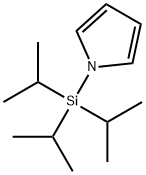| Identification | More | [Name]
1-(TRIISOPROPYLSILYL)PYRROLE | [CAS]
87630-35-1 | [Synonyms]
1-TRIISOPROPYLSILANYL-1H-PYRROLE
1-(TRIISOPROPYLSILYL)PYRROLE
N-TRIISOPROPYLSILYL PYRROLE
1-(Triisopropylsilyl)-1H-pyrrole
TIPS-pyrrole | [Molecular Formula]
C13H25NSi | [MDL Number]
MFCD00054932 | [Molecular Weight]
223.43 | [MOL File]
87630-35-1.mol |
| Chemical Properties | Back Directory | [Boiling point ]
78 °C0.4 mm Hg(lit.) | [density ]
0.904 g/mL at 25 °C(lit.)
| [refractive index ]
n20/D 1.492(lit.)
| [Fp ]
224 °F
| [storage temp. ]
Inert atmosphere,2-8°C | [pka]
-2.55±0.70(Predicted) | [Specific Gravity]
0.904 | [Water Solubility ]
Not miscible in water. | [Hydrolytic Sensitivity]
7: reacts slowly with moisture/water | [Sensitive ]
Moisture Sensitive | [BRN ]
3540663 | [CAS DataBase Reference]
87630-35-1(CAS DataBase Reference) |
| Hazard Information | Back Directory | [Uses]
1-(Triisopropylsilyl)pyrrole may be employed as reagent in perfluoroalkylation and Vilsmeier formylation reactions. It may be used in the preparation of:
- ethyl 2-(2,4-dinitrophenylhydrazono]-3-[ 1-(triisopropylsily1)-pyrrol-2-yflpropanoate
- heterocyclic base, 3-nitropyrrole
- 3-nitropyrrole, required for the synthesis of 1 -(2′-deoxy-β-D-ribofuranosyl)-3-nitropyrrole
| [Uses]
1-(Triisopropylsilyl)pyrrole may be employed as reagent in perfluoroalkylation and Vilsmeier formylation reactions. It may be used in the preparation of ethyl 2-(2,4-dinitrophenylhydrazono]-3-[ 1-(triisopropylsily1)-pyrrol-2-yflpropanoate; heterocyclic base, 3-nitropyrrole and 3-nitropyrrole, required for the synthesis of 1 -(2?-deoxy-β-D-ribofuranosyl)-3-nitropyrrole. It participates in various electrophilic substitution reactions specifically at β-position, via reaction with various electrophilic reagents (Br+, I+,NO2+,etc). | [General Description]
1-(Triisopropylsilyl)pyrrole (TISP), a heterocyclic building block, is a pyrrole derivative. TISP has been reported to generate pyrrolic cation radicals during cyclovoltammetric studies, via electroreduction. It participates in various electrophilic substitution reactions specifically at β-position, via reaction with various electrophilic reagents (Br+, I+,NO2+,etc). |
|
|





